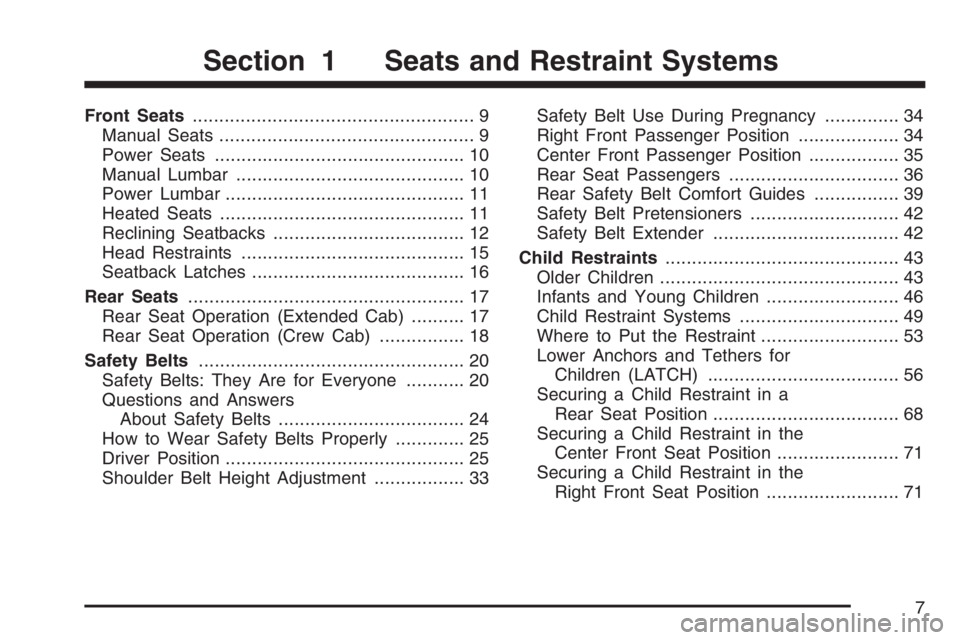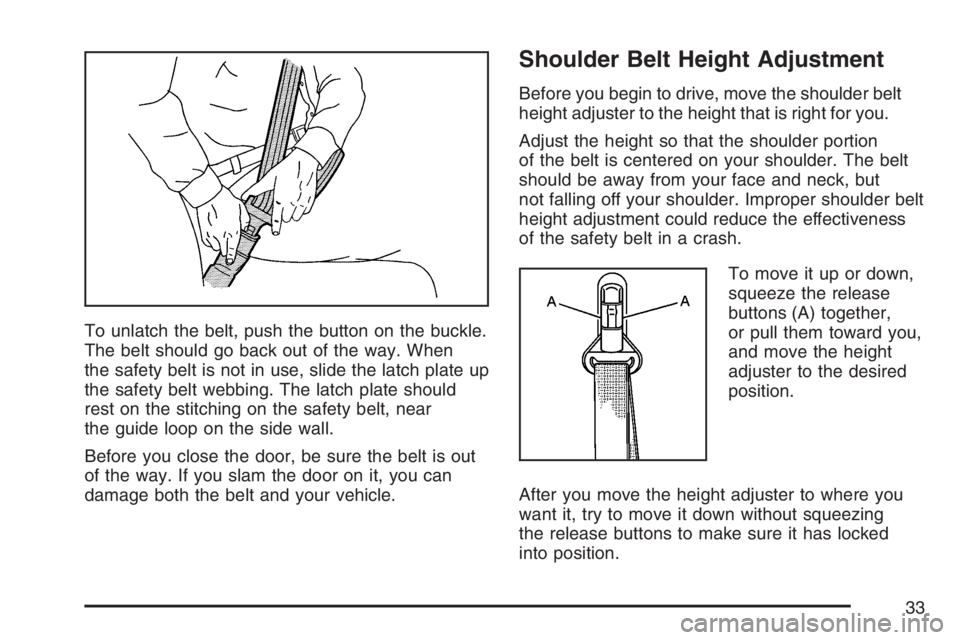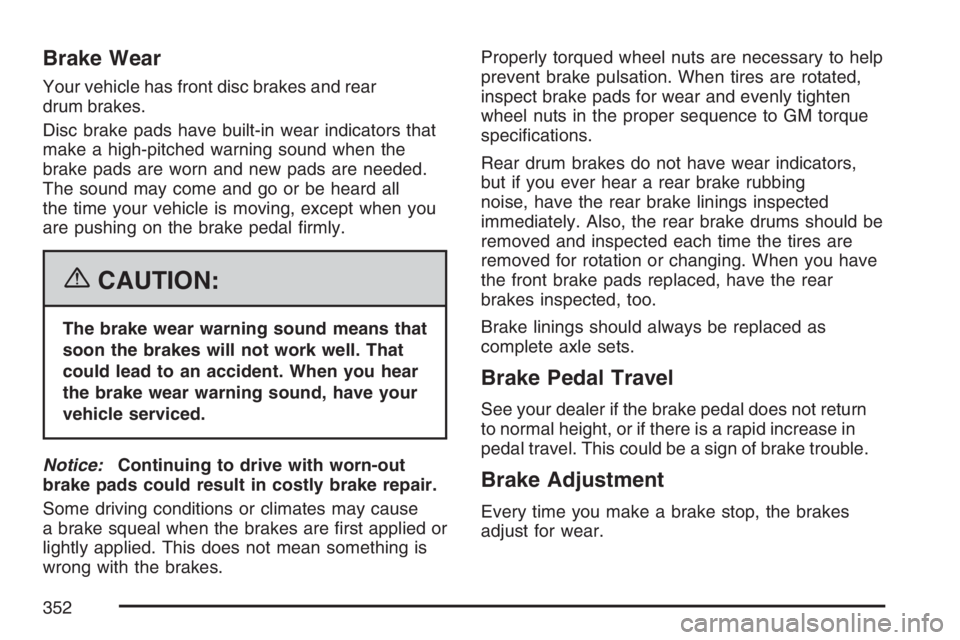height adjustment GMC CANYON 2007 Owner's Manual
[x] Cancel search | Manufacturer: GMC, Model Year: 2007, Model line: CANYON, Model: GMC CANYON 2007Pages: 492, PDF Size: 2.79 MB
Page 7 of 492

Front Seats..................................................... 9
Manual Seats................................................ 9
Power Seats............................................... 10
Manual Lumbar........................................... 10
Power Lumbar............................................. 11
Heated Seats.............................................. 11
Reclining Seatbacks.................................... 12
Head Restraints.......................................... 15
Seatback Latches........................................ 16
Rear Seats.................................................... 17
Rear Seat Operation (Extended Cab).......... 17
Rear Seat Operation (Crew Cab)................ 18
Safety Belts.................................................. 20
Safety Belts: They Are for Everyone........... 20
Questions and Answers
About Safety Belts................................... 24
How to Wear Safety Belts Properly............. 25
Driver Position............................................. 25
Shoulder Belt Height Adjustment................. 33Safety Belt Use During Pregnancy.............. 34
Right Front Passenger Position................... 34
Center Front Passenger Position................. 35
Rear Seat Passengers................................ 36
Rear Safety Belt Comfort Guides................ 39
Safety Belt Pretensioners............................ 42
Safety Belt Extender................................... 42
Child Restraints............................................ 43
Older Children............................................. 43
Infants and Young Children......................... 46
Child Restraint Systems.............................. 49
Where to Put the Restraint.......................... 53
Lower Anchors and Tethers for
Children (LATCH).................................... 56
Securing a Child Restraint in a
Rear Seat Position................................... 68
Securing a Child Restraint in the
Center Front Seat Position....................... 71
Securing a Child Restraint in the
Right Front Seat Position......................... 71
Section 1 Seats and Restraint Systems
7
Page 26 of 492

3. Pick up the latch plate and pull the belt across
you. Do not let it get twisted.
The lap-shoulder belt may lock if you pull the
belt across you very quickly. If this happens,
let the belt go back slightly to unlock it.
Then pull the belt across you more slowly.4. Push the latch plate into the buckle until
it clicks.
Pull up on the latch plate to make sure it is
secure. If the belt is not long enough,
seeSafety Belt Extender on page 42.
Make sure the release button on the buckle is
positioned so you would be able to unbuckle
the safety belt quickly if you ever had to.
5. Move the shoulder belt height adjuster to the
height that is right for you. Improper shoulder
belt height adjustment could reduce the
effectiveness of the safety belt in a crash. See
Shoulder Belt Height Adjustment on page 33.
26
Page 33 of 492

To unlatch the belt, push the button on the buckle.
The belt should go back out of the way. When
the safety belt is not in use, slide the latch plate up
the safety belt webbing. The latch plate should
rest on the stitching on the safety belt, near
the guide loop on the side wall.
Before you close the door, be sure the belt is out
of the way. If you slam the door on it, you can
damage both the belt and your vehicle.
Shoulder Belt Height Adjustment
Before you begin to drive, move the shoulder belt
height adjuster to the height that is right for you.
Adjust the height so that the shoulder portion
of the belt is centered on your shoulder. The belt
should be away from your face and neck, but
not falling off your shoulder. Improper shoulder belt
height adjustment could reduce the effectiveness
of the safety belt in a crash.
To move it up or down,
squeeze the release
buttons (A) together,
or pull them toward you,
and move the height
adjuster to the desired
position.
After you move the height adjuster to where you
want it, try to move it down without squeezing
the release buttons to make sure it has locked
into position.
33
Page 352 of 492

Brake Wear
Your vehicle has front disc brakes and rear
drum brakes.
Disc brake pads have built-in wear indicators that
make a high-pitched warning sound when the
brake pads are worn and new pads are needed.
The sound may come and go or be heard all
the time your vehicle is moving, except when you
are pushing on the brake pedal �rmly.
{CAUTION:
The brake wear warning sound means that
soon the brakes will not work well. That
could lead to an accident. When you hear
the brake wear warning sound, have your
vehicle serviced.
Notice:Continuing to drive with worn-out
brake pads could result in costly brake repair.
Some driving conditions or climates may cause
a brake squeal when the brakes are �rst applied or
lightly applied. This does not mean something is
wrong with the brakes.Properly torqued wheel nuts are necessary to help
prevent brake pulsation. When tires are rotated,
inspect brake pads for wear and evenly tighten
wheel nuts in the proper sequence to GM torque
speci�cations.
Rear drum brakes do not have wear indicators,
but if you ever hear a rear brake rubbing
noise, have the rear brake linings inspected
immediately. Also, the rear brake drums should be
removed and inspected each time the tires are
removed for rotation or changing. When you have
the front brake pads replaced, have the rear
brakes inspected, too.
Brake linings should always be replaced as
complete axle sets.
Brake Pedal Travel
See your dealer if the brake pedal does not return
to normal height, or if there is a rapid increase in
pedal travel. This could be a sign of brake trouble.
Brake Adjustment
Every time you make a brake stop, the brakes
adjust for wear.
352